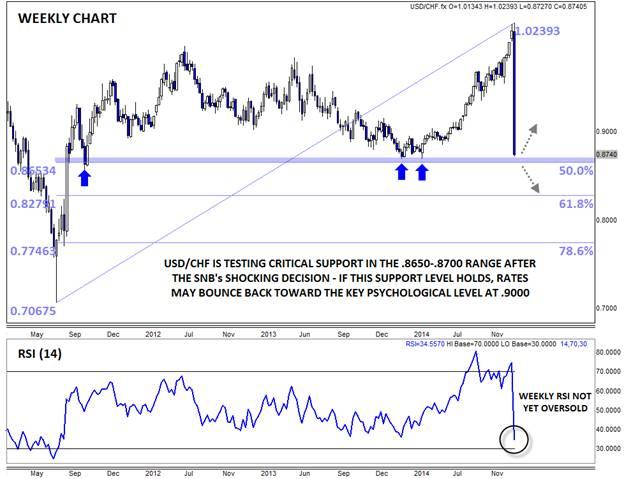CHF Safe Haven Comeback: Why the SNB's Shocking Decision May Hurt the Buck
Unless you’ve been living under a rock, you’ve heard that the SNB made the shocking decision to drop its peg at 1.20 in the EURCHF, prompting the Swiss franc to surge around 15% across the board (for instant analysis on the decision, see my colleague Kathleen Brooks’ report, “SNB Shocker: EURCHF Peg Comes to an End”). It’s as if the SNB was a child holding a beach ball (the franc) underwater, and without warning, the child suddenly decided to go chase a butterfly, and the ball violently erupted back to the surface. While this decision may have major implications for next week’s ECB meeting, traders are still trying to catch up with where the franc stands now.
Throughout 2010 and 2011, the Swiss franc was one of the strongest currencies in the entire FX market. As economic conditions in the Eurozone deteriorated, traders continued to push up the neighboring Swiss franc in a persistent safe haven bid, eventually driving EURCHF to below parity and USDCHF down to nearly .7000. Then on one fateful September morning, the Swiss National Bank decided it had had enough and instituted a floor at 1.20 in EURCHF, reversing much of franc’s recent extreme gains.
Over the last 3.5 years, the peg has been remarkably effective in limiting strength in the Swiss franc, so much so that the franc essentially became the euro: When the euro fell on concerns about Greece or Portugal, the franc fell in sympathy, and when the euro rallied after ECB President Draghi vowed to do “whatever it takes” to defend the Eurozone, the franc surged in lockstep.
With the peg now gone, everything has changed. Though the SNB has taken some measures to discourage speculation in its current, including cutting the deposit rate to -0.75% and rumored intervention at the peak of this morning’s euphoria, the franc may now revert to its traditional safe haven status. Therefore, instead of the two FX safe havens that traders have grown accustomed to over the last three years (the US dollar and Japanese yen), there’s a new currency that could vie for safe haven flows in times of stress. At the margin, this new dynamic could reduce demand for the dollar, though it should be noted that the US still sports higher short-term interest rates then Japan and Switzerland.
Technical View: USDCHF
Not surprisingly, USDCHF collapsed in the wake of the announcement, and the pair is now testing a key long-term support level. As the weekly chart (below) shows, the pair is testing previous support at the 50% Fibonacci retracement of the entire post-EURCHF-floor rally in the .8650-.8700 zone. Now that the initial panic has slowed down, bulls are desperately hoping that this support level will hold. If it does, it could open the door for a recovery back toward the psychologically-significant .9000 level, but if .8650 is conclusively broken, USDCHF may fall further, with no meaningful long-term support until the 61.8% Fibonacci retracement around .8300.


